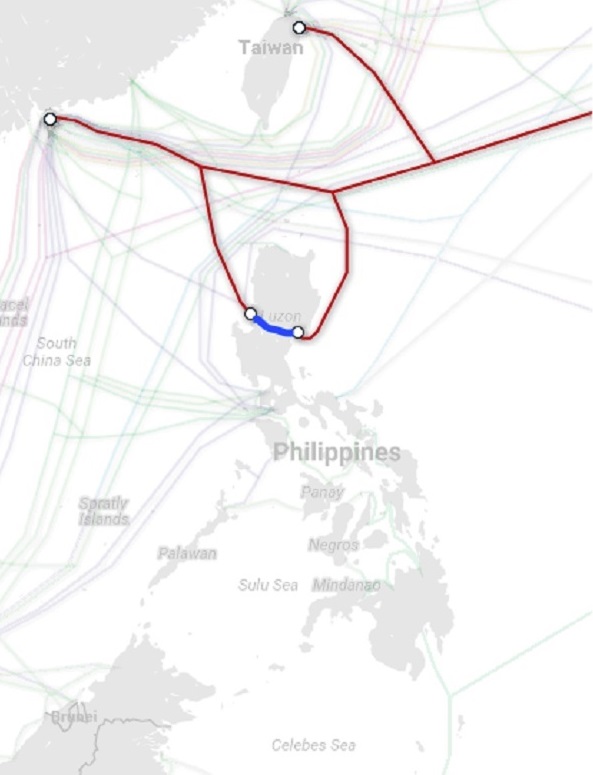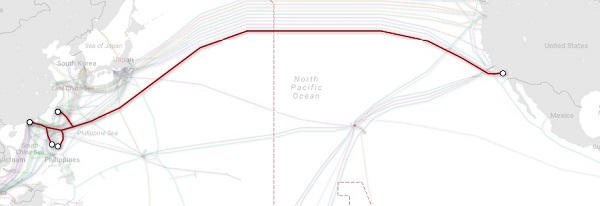 This article was authored by Grace In Mono, and was originally posted on telecomasia.net.
This article was authored by Grace In Mono, and was originally posted on telecomasia.net.
Much has been said about the landing party agreement between the Philippine government and Facebook. And most of it is quite technical.
Pacific Light Cable Network (PLCN), an international submarine cable consortium connecting the US to Hong Kong and Taiwan, will land a fiber optic cable in the Philippines and use the Luzon Bypass Infrastructure (LBI), a 250-km cable corridor connecting a landing station in Baler, Aurora with another one in Poro Point, San Fernando, La Union, as a redundancy route.
The Bases Conversion and Development Authority (BCDA), a government owned and operated corporation, will build the two landing stations and cable corridor that make up the LBI. Upon completion, BCDA will turn over the facilities to Department of ICT, who will operate and maintain the facility for 25 years (extendable for another 25 years). In return for using the LBI, Facebook will remunerate the Philippine government with 2Tbps of cable capacity.
 As stated in the BCDA-DICT framework agreement, “the convergence of both DICT’s and BCDA’s resources can help further develop and improve government internet connectivity.”
As stated in the BCDA-DICT framework agreement, “the convergence of both DICT’s and BCDA’s resources can help further develop and improve government internet connectivity.”
What is not often talked about is the backend work that went behind this deal and the huge potential financial benefits, which can disrupt not only telecommunications but the whole Philippine economy.
The story began in 2014 when some tech entrepreneurs contacted the Department of Science and Technology’s Advanced Science and Technology Institute (DOST-ASTI) about its work, particularly on the Philippine Open IX. This initial contact, which built trust and a good working relationship, would eventually lead to a link with Facebook who was then exploring ways of getting a better path going to Asia.
In early 2015, the idea of an international submarine cable and a bypass infrastructure in the Philippines were first discussed with ASTI’s former director Engr. Denis Villorente and, later on, to ICT Office’s executive director, Louis Casambre. When the Department of ICT was created in mid-2016, the proposal was elevated to the DICT secretary.
Just how significant is this deal to the Philippines?
The 2Tbps fiber capacity to be given to the Philippine government has a peso value of P4.8 billion or roughly $96 million a year. For comparison, PLDT is investing 7 billion pesos in the Jupiter undersea cable system that will connect Japan and US to the Philippines.
Meanwhile, the government will spend a one-time cost of 975 million pesos to build the LBI and an annual cost of 100 million pesos to operate and maintain it. It is, however, not clear for how long the Philippines can enjoy the 2Tbps capacity for free.
The LBI will not be exclusive to the PLCN cable. According to DICT OIC Eliseo Rio, Jr., five other international submarine cables are expected to use the LBI to bypass the Luzon Strait where cables often experience breaks due to earthquakes and typhoons. This, according to Rio, would give the Philippine government at least 12 Tbps.
The most exciting change brought about by the deal is that it’s a test case for how open access works. The LBI will be the first open-access, telco-neutral cable landing facility in the country. This will also be the first international cable link which will not deal with a local commercial telco to get bandwidth into the Philippines.
It needs to be clarified, however, that the 2Tbps is just the cable capacity. The government will still have to pay for internet port capacity and/or make peering arrangements to run traffic through the cable.
The Facebook-PH LBI exchange deal will translate to huge savings for the government. As a big client, the government buys transit through the local telcos in large chunks, which now totals 40Gbps. For a 10Gbps capacity, for example, we can estimate the cost at a low of $10-12 to a high of $15-20 per Mb per month. This cost includes the telcos having to “fetch” capacity from the US or Hong Kong or wherever, using their international submarine cable and telco partners, then bringing it back to the Philippines.
With the Facebook deal, the Philippine government will simply pay for the internet port capacity, which can be as low as a dollar to a few centavos per Mb per month. Let’s assume that the government would now exclusively use the PLCN for all its bandwidth needs. If it used to pay $15/Mb per month, this would amount to $600,000 per month for all 40Gbps. Using the PLCN, the government would now only have to spend $40,000 per month if it had to pay $1 per Mb. That’s a savings of $560,000 per month! Now that is value for taxpayers’ money.
The real challenge, however, is the actual execution of the plan. BCDA would probably have to outsource the building of the landing stations and cable link. The government will have to guarantee that environmental standards are met in the landing stations at Poro Point and Baler. It will have to ensure a seamless right of way and a highly secure path for the LBI. And, ultimately, it will have to manage not only the bandwidth but people’s expectations.
If you haven't already, please take our Reader Survey! Just 3 questions to help us better understand who is reading Telecom Ramblings so we can serve you better!
Categories: Other Posts · Undersea cables





Discuss this Post